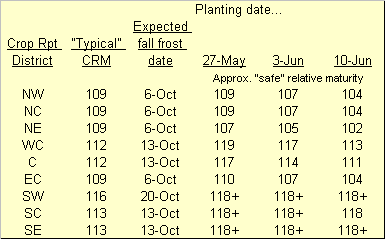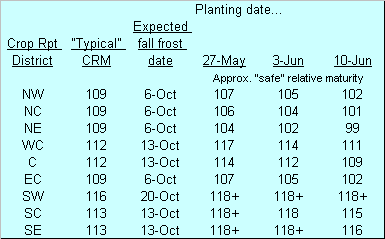

![]() ven
though Indiana's corn planting pace is essentially on par with the 5-year average
(74%
planted as of May 14 vs. 70% planted 5-yr average, according to USDA-NASS),
much of the remaining quarter of the state's corn crop will likely be planted
later than desired due to the excessive rainfall that occurred throughout the
state for most of a seven-day period. Additionally, some of the early-planted
crop may require replanting if plant populations are reduced due to soggy soils
and/or disease.
ven
though Indiana's corn planting pace is essentially on par with the 5-year average
(74%
planted as of May 14 vs. 70% planted 5-yr average, according to USDA-NASS),
much of the remaining quarter of the state's corn crop will likely be planted
later than desired due to the excessive rainfall that occurred throughout the
state for most of a seven-day period. Additionally, some of the early-planted
crop may require replanting if plant populations are reduced due to soggy soils
and/or disease.
A large section of central and northern Indiana received 2 to 4 inches of rainfall over about 7 days, while much of southern Indiana has received 0.5 to 2 inches (based on 7-day precipitation amounts ending 7am 5/16/06, NOAA-NWS Precipitation Analysis). Because of wet and slowly drying fields, some corn planting may not resume until near the end of the month.
Some of the locals who frequent the Chat'n Chew Café are beginning to question whether they should consider replacing their remaining full-season corn hybrids with shorter-season versions. They are worried that full-season hybrids planted in late May or early June may not mature safely before the first killing fall frost.
Fortunately, previous research has indicated that delayed planting results in hybrids maturing in fewer than expected Growing Degree Days (GDDs) from planting (Nielsen et al., 2002). The number of GDDs required from planting to physiological maturity in corn decreases nearly 7 GDDs per day of delayed planting after May 1. An example would be that a hybrid planted June 1 will mature approximately 210 GDDs sooner than it would if planted May 1 (30 days times 7 GDDs/day).
The bottom line from this research is that a given hybrid maturity can be planted later than we once thought possible and still mature safely before a killing fall frost. Nevertheless, at some point on the calendar, growers need to consider switching to earlier maturity hybrids to minimize the risk of frost damage in the fall.
The tables that follow summarize the delayed planting effect on hybrid GDD requirements and present the results in terms of "safe" hybrid maturities for a range of delayed planting dates (see Nielsen & Thomison, 2003, for more information). Both tables assume a fall frost date that is based on a 50% risk of frost occurring by a given date for individual crop reporting districts around the state.
Table 1 targets physiological maturity occurring the week that a killing frost is expected to occur. Table 2 targets physiological maturity occurring the week before a killing frost is expected to occur. The hybrid maturities listed in Table 1 are therefore a bit more risky than those listed in Table 2.
The hybrid maturities are described in terms of "CRM" or comparative relative maturity ratings as defined by Pioneer Hi-Bred International, partly because most growers can relate to those definitions. More importantly, Pioneer publishes hybrid data for both CRM ratings and GDDs from planting to physiological maturity that then allow us to estimate the "safe" hybrid maturities listed in these tables (https://www.pioneer.com/growingpoint).
The tables indicate that growers in the southern third of Indiana could continue to plant full-season hybrid maturities through at least June 10. Growers in the northern third of the state and eastcentral Indiana should consider switching to earlier maturing hybrids if planting is delayed into early June.
Nielsen, Robert L., Peter R. Thomison, Gregory A. Brown, Anthony L. Halter, Jason Wells, and Kirby L. Wuethrich. 2002. Delayed Planting Effects on Flowering and Grain Maturation of Dent Corn. Agron. J. 94:549-558.
Nielsen, R.L. (Bob) and Peter Thomison. 2003. Delayed Planting & Hybrid Maturity Decisions. Purdue Univ. Cooperative Extension Publication AY-312-W. Available online at http://www.agry.purdue.edu/ext/pubs/AY-312-W.pdf [URL verified 5/16/06].
Table 1. Approximate “safe” relative hybrid
maturities for late planting dates in Indiana with the assumption that the hybrid
will mature the week of the expected first fall frost date. The expected fall
frost date is that based on a 50% risk of frost occurrence. The acronym “CRM”
refers to Comparative Relative Maturity as defined by Pioneer Hi-Bred International.

Table 2. Approximate “safe” relative hybrid
maturities for late planting dates in Indiana with the assumption that the hybrid
will mature one week before the expected first fall frost date. The expected
fall frost date is that based on a 50% risk of frost occurrence. The acronym
“CRM” refers to Comparative Relative Maturity as defined by Pioneer
Hi-Bred International.

© 2006 , Purdue University, an equal access, equal opportunity university. This material may be available in alternative formats. If you have trouble accessing this page because of a disability, please contact RLNielsen at rnielsen@purdue.edu.